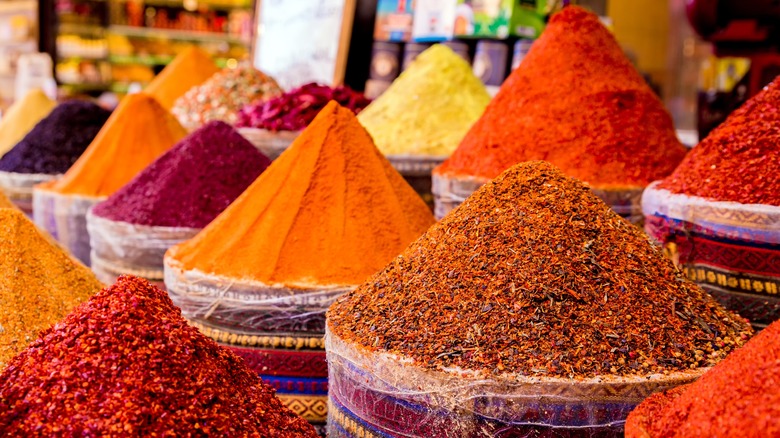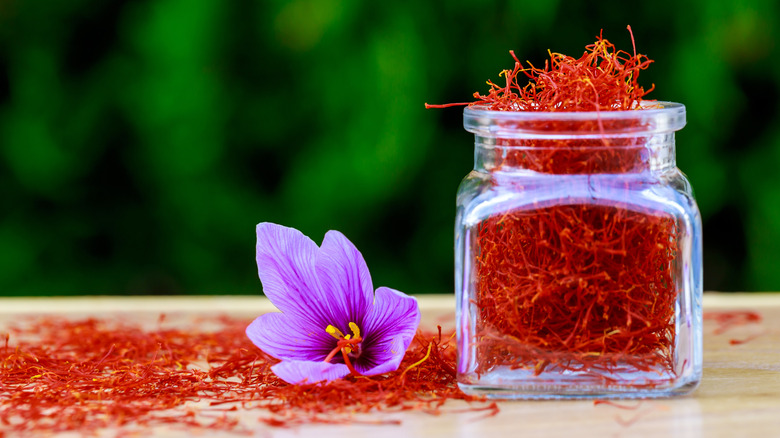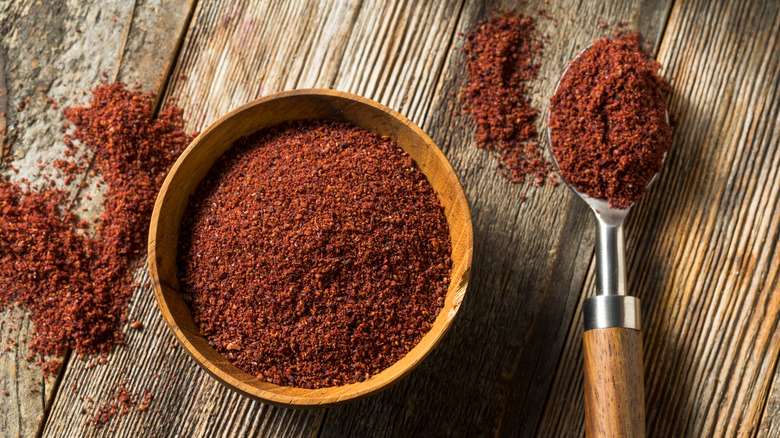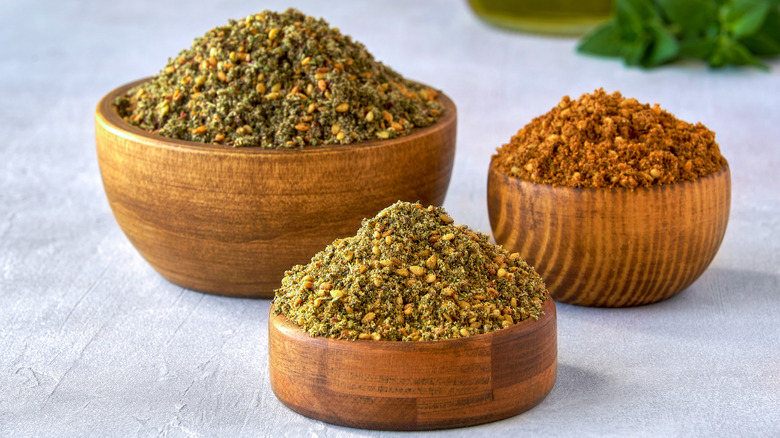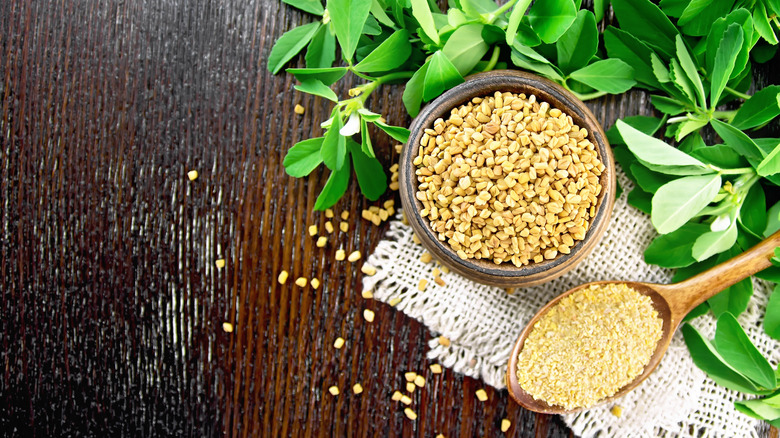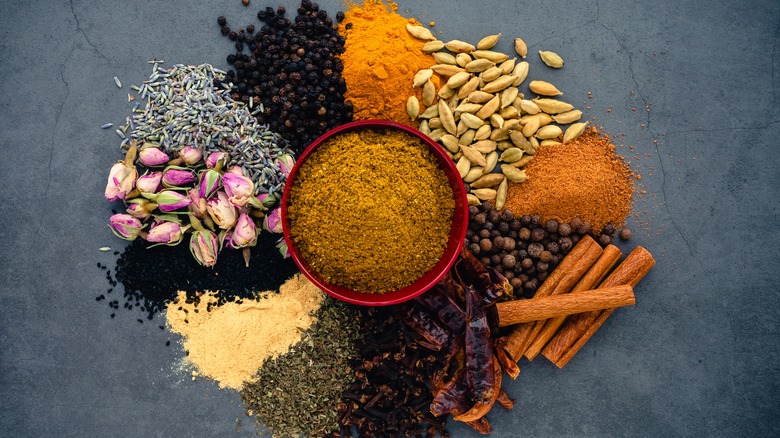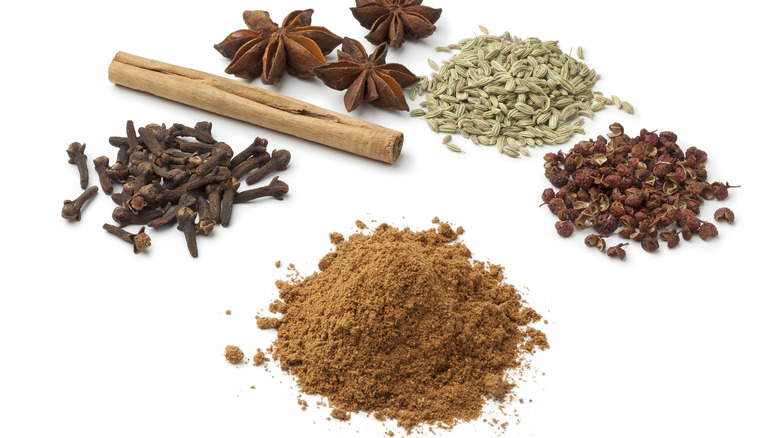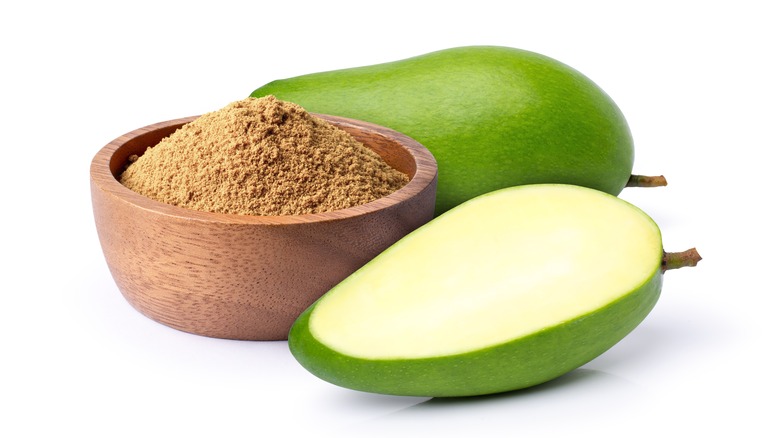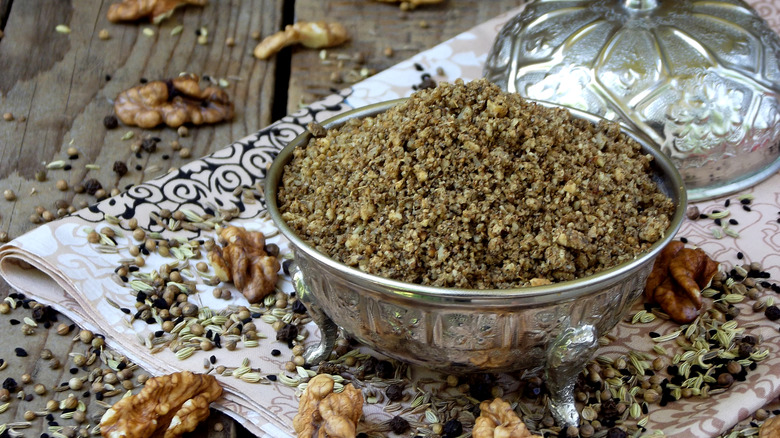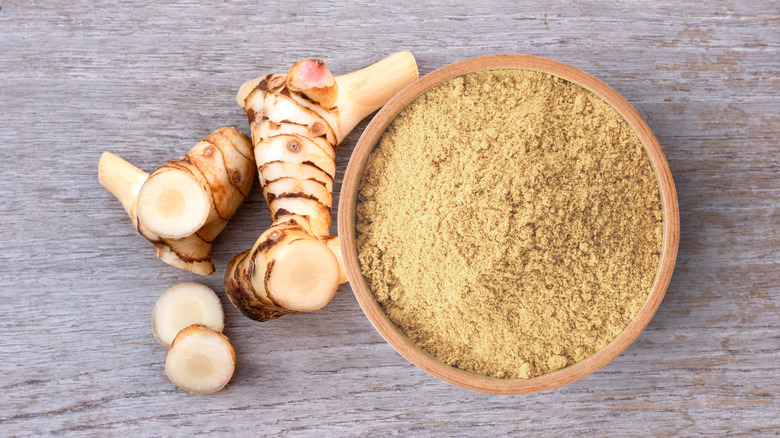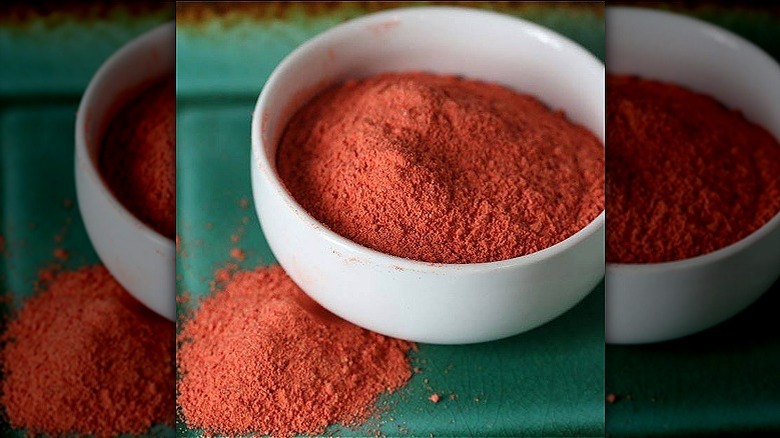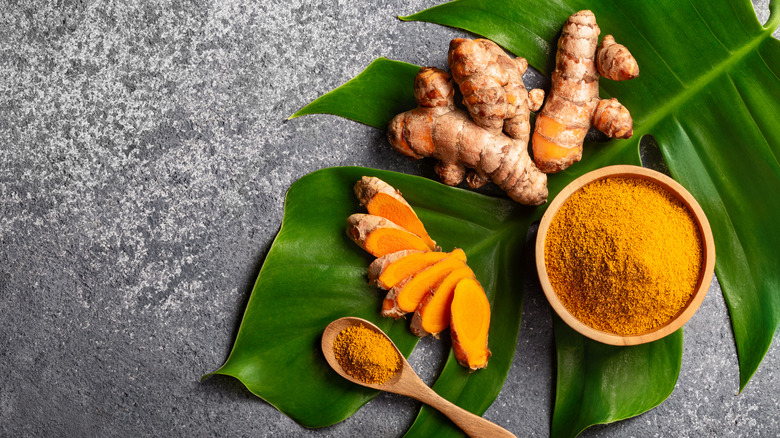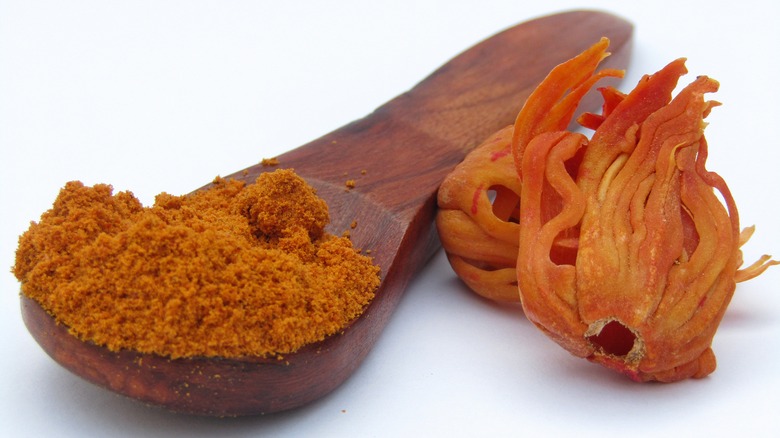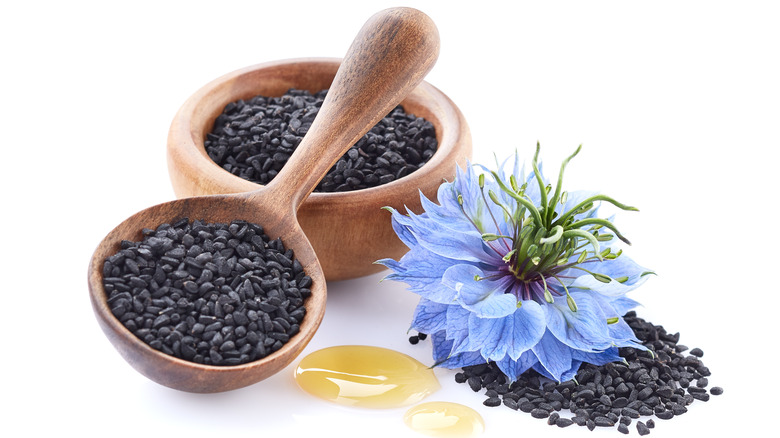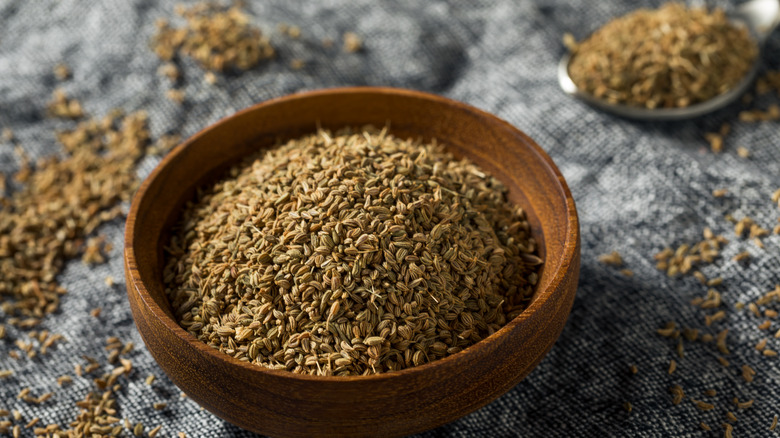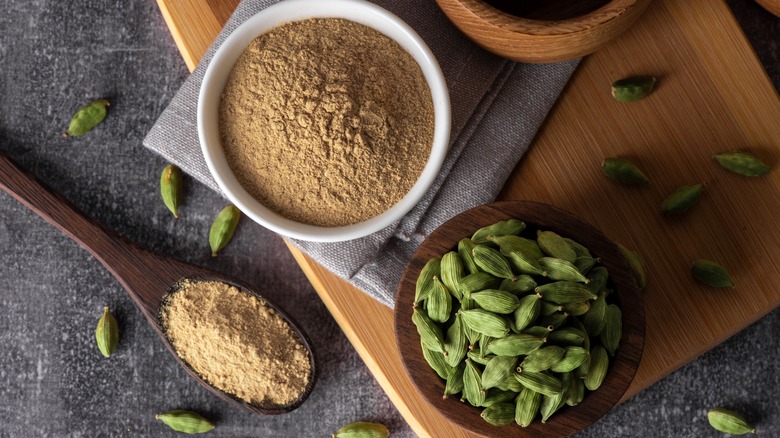15 Exotic Spices And How To Use Them
The use of herbs and spices for culinary purposes is ubiquitous in cultures across the globe. Not only do specific spices and blends indicate the culinary identity of a people, but it also informs us of each country's distinct climate, ethnic diversity, religious rituals, and the arc of their interactions with other countries and people throughout history. It is also a powerful emblem of wealth and prestige, often serving as the impetus for colonization.
Research suggests that spices may have emerged as an evolutionary adaptation to solve the problem of curtailing the onset of foodborne illnesses, particularly in cultures located in warmer climates that consume meat, via the American Institute of Biological Sciences. While this may explain how spices evolved, their proliferation across the globe began as early as 3,500 years ago, as evidenced by Egyptian scrolls. The spice trade continued to expand by land in 950 B.C. with the Arab trade routes. By 1498, the Portuguese prospector Vasco da Gama embarked on the first sea expedition around the tip of Africa to India, solidifying the trade routes from India to Europe.
Today, spices of all kinds flow freely from one country to another. While we may have access to virtually any spice blend known to man at our fingertips, few of us know about or understand how to implement more exotic spices into our culinary repertoires, which is why we sought to identify some of the more exotic spices available and to define how to use them.
1. Saffron
No discussion about exotic spices would be complete without including the most exotic — saffron. Saffron is the stigma of the crocus sativus flower and is the most expensive spice in the world. One pound of this spice can set you back anywhere from $500 to $5,000, depending upon the source and quality. Its cost is the by-product of how it is harvested, by hand, making it intensively laborious to obtain. Current archaeological and genetic research has revealed that saffron was most likely first cultivated in Greece around 1700 B.C. It then spread throughout the Middle East and Asia, with Iran being the largest producer worldwide.
Saffron is known for its myriad purported health benefits, including antioxidant, anti-inflammatory, anti-depressive, anti-carcinogenic, and aphrodisiac properties, according to Healthline. From a culinary perspective, however, it is best known for the vibrant color and subtle floral flavor it lends to dishes. The most common are classic Spanish paella, Iranian jujeh kebabs, French bouillabaisse, Italian Milanese risotto, and Indian korma. It is particularly effective in rice dishes and stews where its flavor and color can shine.
When purchasing saffron, be careful to buy it from a reputable retailer. Search for saffron that is a bright red color, not brassy. It should smell slightly flowery and sweet. And never purchase anything labeled as ground saffron. If saffron sounds like a bargain, don't buy it. And remember, a little goes a long way, but there is no substitute for saffron, so don't attempt to use turmeric or paprika as a cheat.
2. Sumac
Sumac is a spice most commonly associated with Middle Eastern dishes, including Palestine, Lebanon, Syria, and Turkey. This spice comes from a shrub in a family of plants native to subtropical and temperate climates. While over 200 species exist, rhus coriaria, or Syrian sumac, is the most often used for cooking. The shrub has bright red cones of tiny fruits that get ground into a pulp and sun-dried. Beware not to conflate this spice with its cousin, poison sumac, which has white fruit and can yield allergies like poison ivy or oak.
Sumac has been used globally for medicinal purposes, from regulating blood sugar to promoting heart health to easing muscle cramps, via Healthline. While it has a spectacular color in dishes, its biggest culinary superpower is its floral citrus aroma and complex taste, which is simultaneously lemony, acidic, metallic, and tart with just a hint of sweetness. Frequent uses are as a garnish for dips like hummus, a marinade for meats, a seasoning in salads like fattoush or stews like the Lebanese musakhan, a pop of color in pastries, and an infusion in cocktails and teas.
Our favorite uses for sumac are in seafood dishes. Because sumac often gets substituted for other acidic components, like lemon juice or vinegar, it lends itself to fish and shellfish. It can also be a great addition to a vinaigrette for a brilliant color. Finally, try it in soups featuring legumes, like a red lentil soup, to help brighten the flavor and cut through the grainy texture.
3. Za'atar
Among the more popular spice blends utilized across the Middle East is Za'atar. Za'atar is typically a blend of thyme, oregano, sesame seeds, sumac, and salt. It has enjoyed a long history as a source of healing thanks to its purported medicinal properties, documented as far back as the 12th century. The sumac in this blend may have anti-inflammatory, anti-fungal, anti-viral, and cancer-fighting elements, via Medical Daily. Herbs like thyme and oregano have compounds that may have antiseptic and antimicrobial qualities. And still, other studies have indicated that this combination may benefit memory and brain health.
Health benefits aside, the flavor is what matters for food enthusiasts. It frequently appears sprinkled atop bread, dips, meats, over vegetables, and as an ingredient in salad dressings. It is also commonly combined with labneh, a Lebanese yogurt cheese. This mixture gets consumed at breakfast with some hearty bread. And finally, try it in stews or soups, particularly with beef or lamb, where its distinct, slightly tangy, nutty, herbal flavor can bounce off the minerally meat.
We recommend exercising some caution when purchasing Za'atar. Many purveyors will substitute citric acid for the sumac and add wheat to bulk up their Za'atar recipe, which is not only inauthentic, it can be problematic for anyone who is gluten-intolerant. Be sure to read the label for allergen warnings. If you aren't sure, ask.
4. Fenugreek
Fenugreek, or trigonella foenum-graecum, is a legume indigenous to the Middle East. It's featured in culinary traditions across North Africa, the Mediterranean, and India. While the leaves of the plant can get used, the plant more often gets sought out for its somewhat square-shaped amber seeds. When toasted and ground, the flavor of these seeds is slightly bitter with a sweet burnt-sugar undertone. It is a popular spice in many countries due to its medicinal properties. Perhaps its most well-documented property is as an aid in stimulating lactation in new mothers, according to Healthline.
From a culinary perspective, this is a spice that is particularly popular in India, where it is frequently the star of dishes like Aloo Methi, a potato curry, Methi Dal, a pigeon pea stew, and Methi Paneer, a spinach and paneer stew. It also appears in the Ethiopian Berbere spice blend and a type of Ethiopian clarified butter called Niter Kibbeh. And if you have ever had a high-quality homemade Italian sausage, you will often taste its pungent flavor there. Try it sprinkled atop a pork loin roast or a roast chicken for a pop of flavor.
Be careful not to mix up fenugreek with fennel. The names may sound familiar, but these are different plants with distinct flavors. Fennel is a part of the carrot and parsley family, and it has an aggressive licorice flavor in both its seeds and leaves, making it more similar to aniseed than fenugreek.
5. Ras el Hanout
When it comes to spice blends, curry often comes to mind, but for those in the know, the Moroccan spice blend of ras el hanout is just as malleable in the kitchen, and often, its flavor is just slightly more nuanced and delicate. The term translates to head of the shop, referring to the notion that the recipe typically features the best spices a spice shop has. While every home has its distinct variation incorporating upwards of 35 or more ingredients in a blend, there are some consistent flavors in most versions we have sampled. At their core is a panoply of sweet and savory spices juxtaposing one another to give ras el hanout its chameleon-like capacity to use in numerous dishes.
In Morocco, you can frequently find this spice blend used in couscous, tagines, meatballs, kebabs, and in cooked salad dishes. There is a saying that a bag of ras el hanout is always gifted to a new bride because even if she is not an experienced cook, her food will still taste delicious if she uses this spice blend. It is not a hyperbolic statement but a truism. We love it on roasted vegetables, in soups, especially carrot or root vegetable soups, and in a play on a classic shrimp scampi paired with some harissa paste and preserved lemons. And for a special treat, add it to softened butter to create a spicy sweet compound butter for fresh summer sweet corn.
6. Chinese 5 Spice
Chinese 5-spice is a blend of spices often seen in the canon of Chinese cuisine but can be found throughout Asia, including Vietnam and Thailand. The most commonly featured spices in Chinese 5-spice are cloves, star anise, Szechuan peppercorn, cinnamon, and fennel seeds. This blend is known as wu xiang fen in Mandarin and ngh heung fan in Cantonese. The number five represents the taste buds – sweet, sour, salty, bitter, and umami. The number five is also meaningful in Chinese medicine, with this combination of spices considered ideal for maintaining optimal health.
Because of its complexity and balance of flavors, this spice is ideal in sweet and savory dishes. It often features in stews, meats, casseroles, and as part of soy-based stocks or stir-fries. However, we love it as a stellar substitute for apple or pumpkin pie spice. We often use it in baked goods, like quickbreads, muffins, cakes, and cookies. It is also spectacular in pancakes, waffles, or a batter for French toast. And if you want to get snazzy, try it in a crème brulée combined with plenty of Madagascar vanilla, a hint of almond extract, and some orange zest for an exotic spin on a classic.
7. Amchur
Am is Hindi for mango, and chur is the word for crushing into a powder. Amchur is a mango powder originating in Northern India thousands of years ago. It is a common ingredient added to vegetarian dishes but also gets featured in stews, chutneys, rice dishes, soups, seafood, and meat because of its distinctive tart flavor. It often replaces lemon, lime juice, and tamarind in recipes where acidity without moisture is required. And because it has a slight sweetness, it can get added to smoothies, puddings, and other desserts.
Amchur is made by harvesting unripened mangoes, peeling them, slicing the meat into strips, sun-drying them, and grinding this dehydrated mango into a powder. According to ayurvedic medicine, amchur has long been known for its health benefits. It is often used for digestion, can help prevent age-related macular degeneration, aids in detoxifying the liver, is a rich source of iron, and has high quantities of vitamin C to combat scurvy, according to Lybrate.
You can obtain amchur online or in Asian grocery stores. When adding amchur to a recipe, use it judiciously. Because of its aggressive tartness, it may quickly overwhelm other flavors in a dish. Add a little at a time with other spices typical of India, such as cumin, coriander, fenugreek, mustard, and chilis. It is fabulous in offsetting starch in potato, bean, or legume recipes and is a powerhouse with fish and seafood, like crab cakes.
8. Dukkah
Dukkah, dukkha, or duqqa is a part spice blend and part condiment hailing from Egypt. It is typically a combination of sesame seeds, salt, pepper, cumin, coriander, and hazelnuts that get forged together into a paste or crumble. Its name comes from the Arabic word to pound, which signals its ancient origins, where it got assembled using a mortar and pestle. Variations are as diverse as are households, with many permutations including different herbs and spices, some adding garlic or chickpeas, occasionally incorporating fresh herbs, and often substituting other nuts for the hazelnuts.
Dukkah was historically consumed as a means of rounding out the diets of ancient Egyptians with a reliable source of protein, fat, and calories. Because of its distinct combination of spices, seeds, and nuts, it is a rich source of mono-unsaturated fatty acids, vitamins, minerals, and antioxidants. It often gets eaten at breakfast with olive oil and bread. And it is a street snack, a kind of Egyptian trail mix you can grab and go when you need a pick-me-up.
Its flavor is nutty, spicy, somewhat citrus forward, and has an earthiness conferred by the cumin. Because of its crunchy texture, it makes an ideal crust for a beef, lamb, or pork roast. It would also be a superb topping for a salad with some salty feta, olives, and fresh summer vegetables. We also like incorporating it into breadcrumbs when making an eggplant or chicken parmesan for a distinctive flavor and crunchy bite.
9. Galangal
Galangal root is a rhizome that is a cousin of ginger and turmeric. Native to Southern Asia, this spice is popular across Thailand, Malaysia, Indonesia, Vietnam, Cambodia, Laos, Singapore, China, and India. While many plants are members of this family, the most often utilized for culinary and traditional medicinal purposes is lesser galangal or alpinia officinarum, according to Healthline. Along with ginger and turmeric, it is a central element in ayurvedic and ancient Chinese medicine and purportedly is rich in antioxidant, anti-inflammatory, anti-bacterial, and cancer-fighting properties. Unlike ginger and turmeric, it often gets utilized to boost male fertility.
When it comes to cooking, galangal gets used fresh or as a dried spice. Although ginger, turmeric, and galangal look alike, their taste is distinct. Galangal tends to be more peppery and less sweet than ginger, although ginger has more of a bite. Galangal also has a citrusy undertone and a hint of pine but is less bitter than turmeric. It is often incorporated into dishes with aggressive fish flavor and paired with coconut milk to tame its spiciness. It is a staple in Thai curries, soups, and noodle dishes and is a fabulous addition to an exotic fruity cocktail.
While it typically gets used fresh, dried galangal can be used interchangeably and is easier to find. The ratio of freshly chopped to dry galangal is one inch of fresh galangal to one teaspoon of dry, but you may need to adjust according to your palate for taste.
10. Li Hing
Li Hing Mui is sweet and salty sour plums that originated in China and were brought to Hawaii in the 1800s by Chinese sugar plantation workers, where it has become a local obsession. Translated, Li Hing Mui means traveling plum in Cantonese. In Hawaii, it travels from island to island. The original Li Hing Mui are the dried plums, which come in packets. You can chew on these dried snacks and then discard the seeds. They get produced by pickling the dehydrated plums with licorice, salt, red food coloring, and either aspartame or sugar.
Li Hing refers to the powder obtained from grinding just the seed of the Li Hing Mui fruit. This spice is everywhere in Hawaii. We first sampled it sprinkled on fresh pineapple and were instantly sold. You will also find it in shaved ice, gummy bears, popcorn, cocktails, Malasadas, and added to lemonade. We have incorporated it into a panoply of dishes, including the poaching liquid for pears or apples, a crème brulée made with mango, chewy coconut macaroons, and even a tropical-inspired carrot cake with cream cheese and Li Hing frosting. Equal parts sweet, sour, and salty, it's a chef's dream in terms of complexity in flavor. One teaspoon of the powder is about as much as you will need for virtually any recipe, as it will instantly turn your dish a bright pink color, and its flavor is quite pervasive.
11. Turmeric
Turmeric, or curcuma longa, is a rhizome in the same family as galangal and ginger root. It originated as part of the Vedic culture of India approximately 4,000 years ago, where it got used for both culinary and medicinal purposes. Its active ingredient, curcumin, has become somewhat of a fad of late thanks to its many health benefits, including antioxidant, anti-inflammatory, antibacterial, and antifungal properties. Research has also shown its positive impact on heart health, cancer prevention, and mitigating the onset of Alzheimer's disease, according to Healthline.
From a culinary perspective, it has long featured prominently in the cuisines of cultures across the globe, from the Caribbean to North Africa to the Middle East and beyond. It is the central ingredient for many spice blends, including curry recipes, ras el hanout, and some chili powders. Aside from its brilliant orange hue, giving it the moniker Indian saffron, it has an aggressive flavor redolent of citrus with a spicy kick, an earthy undertone, and a bitter aftertaste. For this reason, it often is paired with slightly sweeter ingredients to help tame its slightly astringent side.
Turmeric is the ideal seasoning for chicken in stews or kebabs, lentil and bean soups, rice dishes, curries, eggs, and beverages like tea, coffee, and smoothies. It can also give desserts and baked goods a brilliant color but don't overdo it. The flavor can overpower everything else in large quantities, and a pinch can provide that delightful orange hue.
12. Mace
Mace, or myristica fragrans, is a spice that, alongside nutmeg, comes from an evergreen tree indigenous to the island of Banda, the largest island of the Molucca spice island chain of Indonesia. Its use for culinary and medicinal purposes dates back to the first century, although thanks to globalization, it is now a spice featured in cultures across the globe. Mace and nutmeg are symbiotic in that nutmeg is the seed of the fruit of this tree, and mace is the aril or sheath-like covering on the exterior. This spice can be found in small sheets called blades, or ground, although the blades will last longer than the ground spice, which has a short shelf-life.
Mace has long been used medicinally for soothing pain from arthritis, addressing dental problems, increasing blood flow, combatting stress, aiding digestion, and preventing cold and flu symptoms, according to RxList. Its flavor, though similar to nutmeg, is less intense, with hints of sweetness, spiciness, citrus, and a piney undertone. It generally has an amber or rust color, which lends itself to giving dishes a beautiful warm hue.
To say you can use mace in almost any recipe would be an understatement. It is incredibly versatile, appearing in everything from desserts to sauces to fancy cocktails. The key is to add mace toward the end of the cooking process, as it tends to be sensitive to heat and quickly loses its flavor when overcooked. And a little goes a long way — don't overdo it.
13. Nigella seeds
Nigella, kalonji seeds, or nigella sativa, are indigenous to Southwestern Asia and have featured heavily in the cuisines of India, the Middle East, and North Africa for centuries. These teardrop-shaped black seeds have also been utilized for medicinal purposes, as is evidenced by their appearance in the tomb of King Tutankhamun. It is known to have antioxidant, antibacterial, anti-inflammatory, detoxifying, and cancer-fighting properties via Healthline.
It is sometimes known as black cumin, primarily because its flavor has hints of cumin, oregano, and onion, with an earthy, slightly bitter aftertaste. They are savory alternatives to sesame seeds in many dishes. While they often get used as a crunchy garnish atop bread, hummus, and salads, they are exceedingly versatile. They only require a bit of toasting before use to draw out their natural oils and nutty aroma.
Some recipes where they feature prominently are spice blends like Egyptian dukkha and Bengali panch phoron, Ethiopian collard greens, Indian potato stir fries, Middle Eastern salads, roasted vegetables, and red lentil dhal. Consider adding them to your oatmeal for a savory spin, jazzing up your Greek yogurt as a topping for creamy soups, sprinkling them atop a vegetarian pizza, and using them as part of a dry rub for fish, chicken, or pork.
14. Ajwain
Ajwain or carom seeds, or trachyspermum ammi, are a seed-like fruit related to cumin, dill, fennel, coriander, parsley, celery, and parsnips. While this fruit likely originated in modern-day Iran, it exists across North Africa, the Middle East, and India. In India, this spice features integrally in the culinary and medicinal heritage of ayurvedic and siddha traditions. According to WebMD, it is commonly used to aid digestion and has antiviral, antifungal, and antibacterial properties.
While its flavor is similar to thyme or oregano, it is much more aggressive and has a smoky, spicy, bitter aftertaste, so it is rarely consumed raw. It often gets added in small quantities to curries, red lentil dhal, and chana masala. It also appears in Indian bread, from naan to roti to parathas.
It is integral to pakoras, samosas, chutneys, and sauces of all kinds, and it makes a great addition to breading for meat or vegetables. When fried in butter or ghee, a technique known as tarka, it gets used as a garnish on numerous dishes. We recommend adding it to your chicken noodle soup recipe, split pea soup, or minestrone for a complex flavor and a warm, soothing heat.
15. Green Cardamom
The third most expensive spice in the world, after saffron and vanilla, is green cardamom, or elettaria cardamomum, a plant in the same family as ginger that originated in the Cardamom Hills of Southeast India. The queen of spices has featured prominently in the culinary traditions of India, the Middle East, and North Africa for over 4,000 years, although it now gets used across the globe. This spice is typically sold in its green seed pod, although sometimes the decorticated black seed is sold separately or ground.
The health benefits of green cardamom are well documented on Healthline. They are a natural diuretic and have anti-inflammatory and anti-bacterial properties. They also aid digestion, blood sugar regulation, and pulmonary functioning and can deter the onset of halitosis. And the Vikings and Europeans have long used it for its supposed aphrodisiac qualities, which may partly explain its popularity in Scandinavia.
When ground, it is a staple in baking and desserts, giving a rich, spicy warmth to quickbreads, pancakes, cakes, cookies, and rice pudding. When used whole, add it to soups, stews, baked beans, and rice dishes. And don't forget to infuse it into your favorite warm beverages, like spicy hot chocolate or chai tea. To extract extra flavor from the whole pod, lightly toast them in a pan before adding them to your favorite dish.
